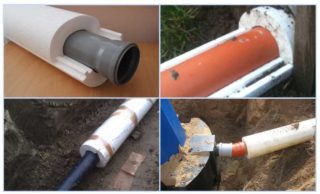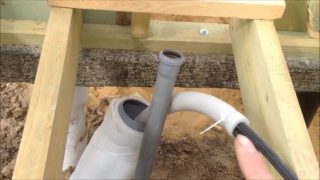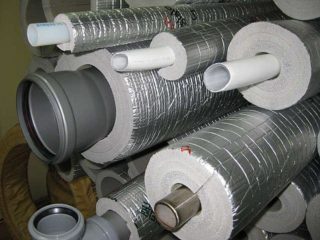Designing and laying a water supply system in a private house is only half the story. When organizing water supply, it is important to provide for the protection of communications from freezing in the cold season. How to competently solve the problem of water supply insulation, what materials and methods to choose and how to avoid mistakes in work, read on.
Why to insulate the external water supply
 The external water supply does not require insulation only if the pipes are laid 50 cm below the level of freezing of the soil. But it is often not possible to carry out sufficient deepening, especially in the northern regions, where the soil freezes up to 2.5 m.
The external water supply does not require insulation only if the pipes are laid 50 cm below the level of freezing of the soil. But it is often not possible to carry out sufficient deepening, especially in the northern regions, where the soil freezes up to 2.5 m.
Together with the freezing of the soil, the water circulating through the pipes will freeze. In this case, the frozen liquid crystallizes and increases in volume by about 10%. This inevitably leads to pipe ruptures - both polypropylene and metal. In case of freezing, part of the pipeline will have to be replaced, since it cannot be repaired. Stop valves also suffer from frozen water, which will also require replacement.
The most vulnerable part of the system is the introduction of a water pipe into the house, where condensation always forms. Therefore, high-quality insulation will additionally protect the house from dampness and help avoid unforeseen costs associated with gusts.
How to protect the pipeline from freezing
If the water supply was laid at a shallow depth or passes above the ground, it is possible to carry out warming in several ways.
Pressure insulation
Water located in pipes under high pressure changes its state of aggregation and does not turn into ice under the influence of frost.
How to implement the method:
- According to the manufacturer, check the pipes for resistance to high pressure - they must withstand up to 5 atm. The pipeline is carefully inspected to identify defects and damage that may interfere with maintaining the desired pressure.
- Insert a submersible pump into the system that will provide high pressure. Behind the pump, a receiver valve is mounted, which prevents the reverse flow of water.
- On the installed receiver, turn off the tap and start the pump. Upon reaching a high pressure level, the device is turned off.
The disadvantage of this method is that it will not be possible to use a pipeline under high pressure.
Heating cable
 A cable with a power of 10-15 W is excellent for warming pipes located at a shallow depth of up to 0.5 m and in the freezing zone of the soil. The heating cable is wound around the outside of the pipe with a given step - the higher the power, the wider the step. Inside the pipe for cable laying provide a special channel. The whole system is connected via a shrink sleeve to a conventional cable with a plug or to the machine.
A cable with a power of 10-15 W is excellent for warming pipes located at a shallow depth of up to 0.5 m and in the freezing zone of the soil. The heating cable is wound around the outside of the pipe with a given step - the higher the power, the wider the step. Inside the pipe for cable laying provide a special channel. The whole system is connected via a shrink sleeve to a conventional cable with a plug or to the machine.
The heating cable from the outside will also have to be insulated with foamed polyethylene and expanded polystyrene. Heating will be enough to include only for winter time or a period of severe frost. The experts consider the method very effective, but the use of electricity for heating is always associated with additional costs.
Air insulation
The essence of the technique is to create an air gap between the pipe and the ground. A corrugated plastic pipe with a diameter of 20-25 cm larger than the main one is put on top of the water supply. The water in the pipeline has a positive temperature, therefore, by itself it will heat the enclosed space “pipe in pipe”, thereby providing protection against freezing.
Heat insulating paint
The construction market offers an innovative means for warming - a paste-like mass on a water or varnish basis with the addition of acrylic dispersion and fillers. The mixture is applied to the outer surface of the pipe using a spray gun with a layer of the desired thickness. Practice shows that heat-insulating paint, applied in several layers, can replace glass wool and even expanded polystyrene.
Materials for thermal insulation
 The simplest and most popular way of warming water pipes in a private house is the use of thermal insulation materials. They must comply with the following technical parameters:
The simplest and most popular way of warming water pipes in a private house is the use of thermal insulation materials. They must comply with the following technical parameters:
- low thermal conductivity;
- durability;
- resistance to temperature changes;
- fire safety;
- ease of installation.
The specified characteristics correspond to at least 5 of the most popular insulation materials.
Fiberglass
Known to everyone, glass wool is a waste of glass production - thin fibers with a binder. This lightweight non-combustible material, resistant to chemical attack and temperature changes, is available in the form of paintings or plates. The only drawback of building materials is the increased moisture absorption, therefore, when arranging the insulation of glass wool, it needs waterproofing. Pipes are wrapped with a layer of glass wool, secured, and a waterproofing layer of roofing material or glassine is equipped on top.
Basalt wool
 In appearance and characteristics, the material is similar to glass wool. It does not react with aggressive chemical compounds, does not attract rodents, does not burn and is not afraid of frost. Basalt cotton wool for insulation of water supply is used in the form of ready-made casings, characterized by increased simplicity and speed of installation. Underground pipelines laid by experts recommend warming with basalt cotton wool with a glued layer of foil isolol or glassine.
In appearance and characteristics, the material is similar to glass wool. It does not react with aggressive chemical compounds, does not attract rodents, does not burn and is not afraid of frost. Basalt cotton wool for insulation of water supply is used in the form of ready-made casings, characterized by increased simplicity and speed of installation. Underground pipelines laid by experts recommend warming with basalt cotton wool with a glued layer of foil isolol or glassine.
Expanded polystyrene
Insulating polystyrene foam (polystyrene) is available in the form of prefabricated casings or shells of a certain diameter. Installation is carried out independently - half the shell is put on the pipe with an offset relative to each other and fixed with a special adhesive tape. The joints are also insulated with tape, and shaped shells are used to warm turns and knots. Cylinders can be produced already with a layer of foil, which gives the material enhanced thermal insulation properties.
Penofol or Isolon
 Foamed polyethylene in the form of penofol or isolon easily tolerates temperature extremes and is easy to install. The material is fixed on the pipes with foil tape or ordinary clamps. If necessary, the insulation layer can be removed for reuse. Best of all, the material shows itself in basement unheated rooms, reducing heat loss.
Foamed polyethylene in the form of penofol or isolon easily tolerates temperature extremes and is easy to install. The material is fixed on the pipes with foil tape or ordinary clamps. If necessary, the insulation layer can be removed for reuse. Best of all, the material shows itself in basement unheated rooms, reducing heat loss.
Mineral wool
Mineral wool is a fibrous material obtained from molten rocks, slags and mixtures thereof. Unlike glass wool, it does not have hygroscopicity, absorbing only 0.5% of moisture from the environment. The material is resistant to fire, the effects of biological and chemical factors - it does not burn and does not grow moldy. The thermal insulation properties of mineral wool depend on the geometry of the fibers - it is recommended to choose varieties of material with randomly directed fiber.
The main mistakes when warming
Rodent damage. Basalt wool as a heater is often damaged by ants and mice. Protection from insects and rodents will be ensured by aluminum foil and metal fine mesh - just wrap pipes with them and secure with reinforced tape.
Lack of integrity. When laying thermal insulation, all parts of the system must be carefully insulated. The slightest omissions can cause depressurization and lead to freezing of the water supply.
Lack of tightness. Before arranging the insulating layer, the pipeline should be carefully checked for defects and damage. The slightest leakage can lead to freezing and breakthrough of the pipe.
Lack of insulation in the basement. The cause of the breakthrough of the water supply can be a low temperature not only on the street, but also in unheated rooms. Therefore, it is necessary to take care of the organization of thermal insulation on pipes in the basement and utility rooms.
Winter work. The warm season allows warming the water supply system more efficiently. In the summer there is the opportunity to conduct a thorough analysis of the pipeline and leisurely equip all the insulating layers.


